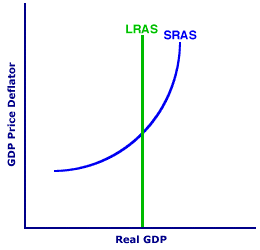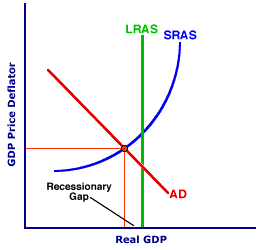
|
|
DISEQUILIBRIUM, LONG-RUN AGGREGATE MARKET: The state of the long-run aggregate market in which real aggregate expenditures are NOT equal to full-employment real production, which result in imbalances that induce changes in the price level. In other words, the opposing forces of aggregate demand (the buyers) and long-run aggregate supply (the sellers) are out of balance. Either the four macroeconomic sector (households, business, government, and foreign) buyers are unable to purchase all of the real production that they seek at the existing price level or business-sector producers are unable to sell all of the full-employment real production that they have available at the existing price level.
Visit the GLOSS*arama
|
|


|

|
                           EXPANSIONARY FISCAL POLICY: A form of fiscal policy in which an increase in government purchases, a decrease in taxes, and/or an increase in transfer payments are used to correct the problems of a business-cycle contraction. The goal of expansionary fiscal policy is to close a recessionary gap, stimulate the economy, and decrease the unemployment rate. Expansionary fiscal policy is often supported by expansionary monetary policy. An alternative is contractionary fiscal policy. Expansionary fiscal policy is designed to stimulate the economy during or anticipation of a business-cycle contraction. This is accomplished by increasing aggregate expenditures and aggregate demand through an increase in government spending (both government purchases and transfer payments) or a decrease in taxes. Expansionary fiscal policy leads to a larger government budget deficit or a smaller budget surplus.In general, expansionary fiscal policy works through the two sides of the government's fiscal budget -- spending and taxes. However, it's often useful to separate these two sides into three specific tools -- government purchases, taxes, and transfer payments. Government PurchasesOne of the three fiscal policy tools available to the government sector is government purchases. Government purchases are expenditures by the government sector, especially those by the federal government, on final goods or services. It is that portion of gross domestic product purchased by governments.These purchases are used to buy everything from aircraft carriers to paper clips, from office furniture to highway construction, from traffic lights to teacher salaries. The actual purchases are typically undertaken by individual government agencies. Highway construction, for example, is undertaken with funds appropriated to the Department of Transportation. Aircraft carriers are financed with funds appropriated to the Department of Defense. Expansionary fiscal policy involves an increase in the funds appropriated to these assorted agencies. The agencies then make the additional purchases which stimulate aggregate production, boost income, and increase the level of employment. While an increase in government purchases have been used frequently over the years to implement expansionary fiscal policy, it can be a relatively involved process. Moreover, additional government purchases leads to a relatively larger government sector. For these reason, policy makers often opt for the second fiscal policy tool -- taxes. TaxesThe second of three fiscal policy tools is taxes, primarily personal income taxes levied by the federal government, but other taxes are also used. Taxes are the involuntary payments that the government sector imposes on the rest of the economy to generate the revenue needed to provide public goods and to undertake other government functions. Personal income taxes are more specifically the taxes collected on the income received by members of the household sector.The federal income tax system, administered by the Internal Revenue Service (IRS), involves a set of tax rates that are applied to the income received by the taxpayers. The bulk of the taxes are withheld from employee paychecks by then paid to the federal government by employers. And discrepancy between taxes withheld and the actual tax liability is then settled when income tax returns are filed at the end of the year. Expansionary fiscal policy involves either a decrease of the income tax rates or a one-time rebate of taxes previously paid. The reduction in taxes provides the household sector with additional disposable income that can be used for consumption expenditures, which then stimulates aggregate production and employment and leads to further increases in income. Because tax changes tend to be administratively easier to implement, they are often preferred over government purchases when conducting expansionary fiscal policy. Moreover, political leaders and voters usually prefer a reduction in the tax burden to an increase in government spending. Transfer PaymentsThe third fiscal policy tool is transfer payments. Transfer payments are payments made by the government sector to the household sector with no expectations of productive activity in return. The three common transfer payments are Social Security benefits to the elderly and disable, unemployment compensation to the unemployed, and welfare to the poor.Like the income tax system, transfer payments rely on a payment schedule based on qualifying characteristics of the recipients -- age, employment status, income, etc. Those who meet the criteria then receive payments. Expansionary fiscal policy involves either an increase in payment schedule for one or more of the transfer systems or perhaps some sort of across-the-board lump-sum payment to all who qualify. That is, the unemployment compensation might be increased by 5 percent or all Social Security recipients might receive an extra $500 payment. The increase in transfer payments provides the household sector with additional disposable income that can be used for consumption expenditures, which then stimulates aggregate production and employment and leads to further increases in income. Recessionary GapExpansionary fiscal policy is used to address business-cycle instability that gives rise to the problem of unemployment, that is, to close a recessionary gap. A recessionary gap exists if the existing level of aggregate production is less than what would be produced with the full employment of resources. This gap arises during a business-cycle contraction and typically gives rise to higher rates of unemployment.| Recessionary Gap | 
|
A recessionary gap is commonly illustrated using the aggregate market (AS-AD analysis). The exhibit to the right presents the standard aggregate market. The vertical long-run aggregate supply curve, labeled LRAS, marks full-employment real production. Long-run equilibrium in the aggregate market necessarily results in full-employment real production.The positively-sloped short-run aggregate supply curve is labeled SRAS. Short-run equilibrium in the aggregate market occurs at the price level and real production corresponding to the intersection of the aggregate demand curve and this SRAS curve. Should short-run real production fall short of full-employment real production, then a recessionary gap results. However, to identify this gap an aggregate demand curve needs to be added to the graph. To include an aggregate demand curve that generates a recessionary gap for this aggregate market, click the [Recessionary Gap] button. Doing so reveals a short-run equilibrium level of real production that is less than full employment, which is a recessionary situation. Note that the aggregate demand curve intersects the SRAS curve at a real production level to the left of the LRAS curve. This means the short-run real production is less than full-employment real production. The difference between short-run equilibrium real production and full-employment real production is the recessionary gap. Closing the GapExpansionary fiscal policy is designed to close a recessionary gap by changing aggregate expenditures and shifting the aggregate demand curve. A recessionary gap is closed with a rightward shift of the aggregate demand curve.| Recessionary Gap | 
|
To illustrate how this occurs, consider the exhibit to the right. The top panel presents a recessionary gap. The recessionary gap can be closed with expansionary fiscal policy -- an increase in government purchases, a decrease in taxes, or an increase in transfer payments. This policy shifts the aggregate demand curve to the right and closes the gap. To illustrate how this works, click the [Expansionary Policy] button. If done correctly, the aggregate demand curve intersects the short-run aggregate supply curve at the full employment level of aggregate production indicated by the long-run aggregate supply curve.Other Policy OptionsExpansionary fiscal policy is one of several stabilization policies available to the federal government to address business-cycle problems. The Federal Reserve System can also get into the act of stimulating the economy through expansionary monetary policy. Or the Congress and the President can direct actions toward the inflationary problems through contractionary fiscal policy.- Expansionary Monetary Policy: To correct a business-cycle contraction and address the problem of unemployment, the Federal Reserve System can increase the money supply and decrease interest rates. This is accomplished by buying U.S. Treasury securities in the open market, lowering the discount rate, and reducing reserve requirements.
- Contractionary Fiscal Policy: Fiscal policy can also be used to address inflationary problems created by an overheated business-cycle expansion. Contractionary fiscal policy is the opposite of expansionary fiscal policy. It consists of decreasing government purchases, increasing taxes, and decreasing transfer payments. The resulting decrease in the aggregate expenditures, causes a decrease in aggregate production and thus reduces inflationary pressures.

Recommended Citation:EXPANSIONARY FISCAL POLICY, AmosWEB Encyclonomic WEB*pedia, http://www.AmosWEB.com, AmosWEB LLC, 2000-2025. [Accessed: July 18, 2025].
Check Out These Related Terms... | | | | | | |
Or For A Little Background... | | | | | | | | | | | |
And For Further Study... | | | | | | | | | | | | |
Related Websites (Will Open in New Window)... | | | |
Search Again?
Back to the WEB*pedia
|



|

|
BLACK DISMALAPOD
[What's This?]
Today, you are likely to spend a great deal of time browsing about a thrift store seeking to buy either a genuine fake plastic Tiffany lamp or a microwave over that won't burn your popcorn. Be on the lookout for small children selling products door-to-door.
Your Complete Scope
This isn't me! What am I?
|

|
|
The penny is the only coin minted by the U.S. government in which the "face" on the head looks to the right. All others face left.
|

|
|
"A winner is someone who recognizes his God-given talents, works his tail off to develop them into skills, and uses those skills to accomplish his goals. " -- Larry Bird, basketball player
|

|
WE
Walrasian Equilibrium
|

|
|
Tell us what you think about AmosWEB. Like what you see? Have suggestions for improvements? Let us know. Click the User Feedback link.
User Feedback
|


|


